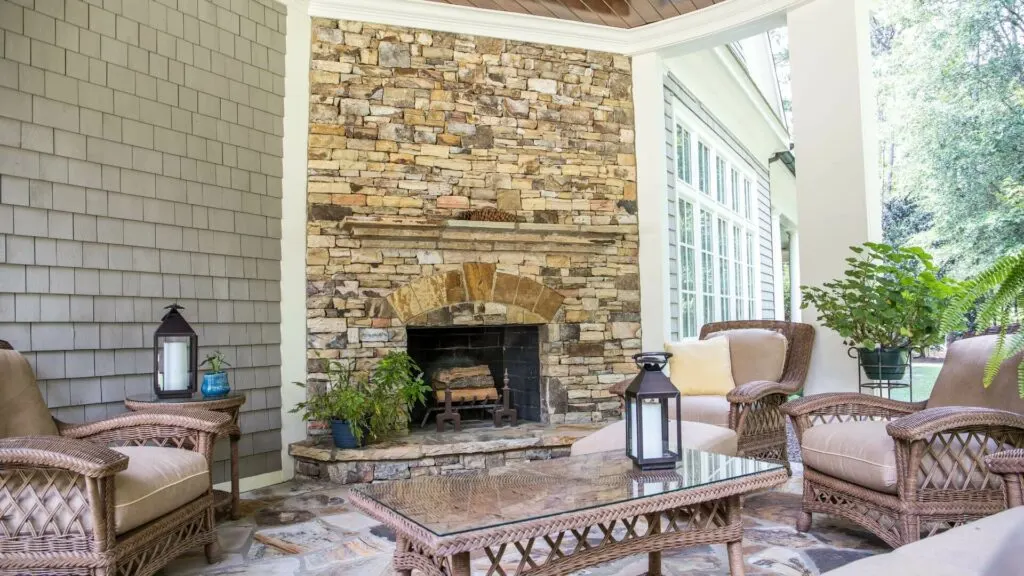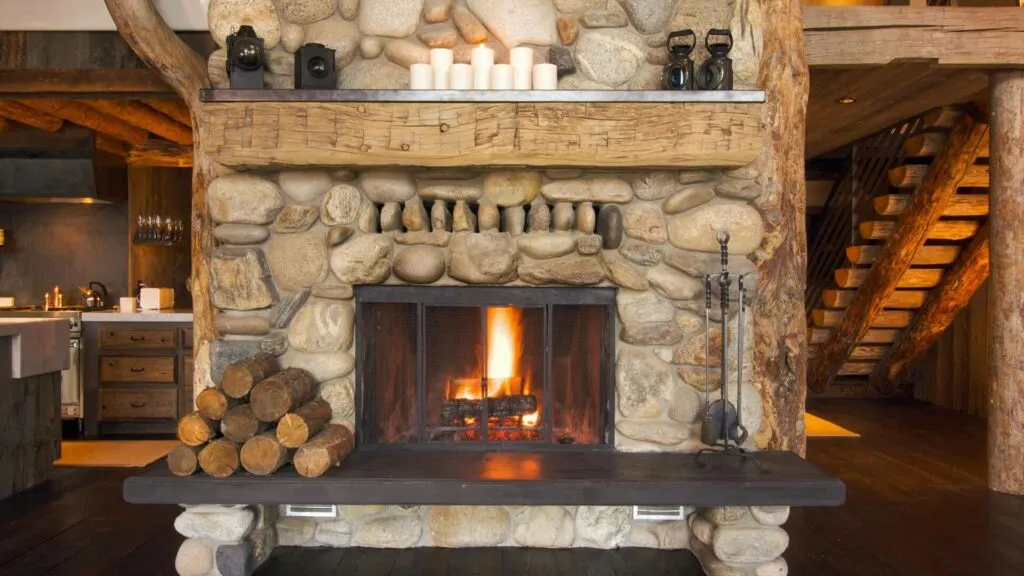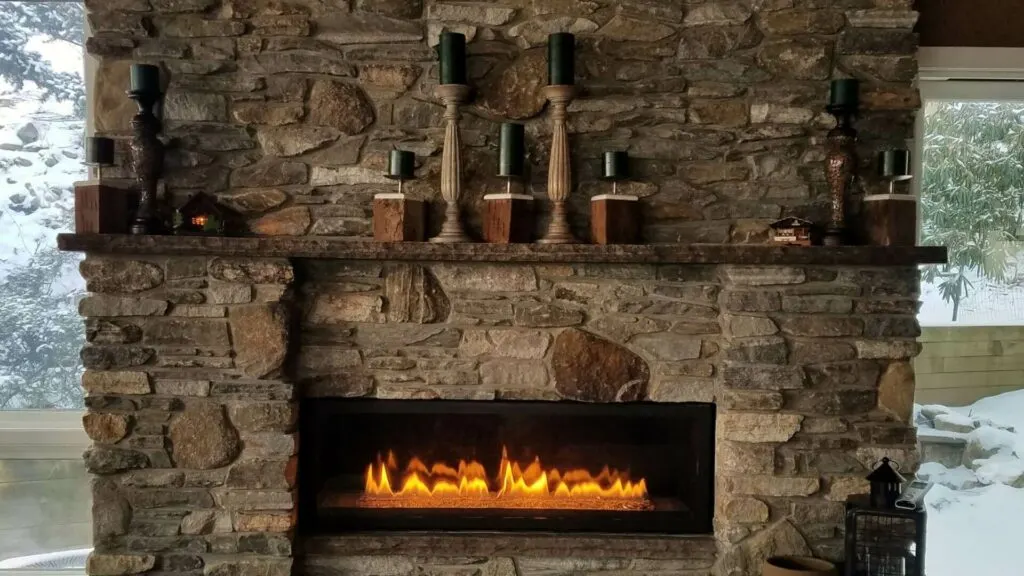Stone fireplaces have become the heart of many homes, adding charm and elegance to any room. The crackling warmth of a stone fireplace casts a cozy glow in any living space.
As their popularity soars, ensuring their longevity and beauty becomes essential.
Join us as we explore expert tips to maintain your stone fireplace, keeping it radiant and inviting for years.
What is a Stone Fireplace?

A stone fireplace is constructed primarily from stone materials, such as natural stone, cultured stone, or stone veneer. It typically consists of a hearth, mantel, and chimney, with the firebox lined or surrounded by stone.
Stone fireplaces are known for their durability, timeless aesthetic, and ability to add warmth and character to interior spaces. They come in various styles, from rustic and traditional to modern and sleek, making them a popular choice for homeowners seeking to enhance the ambiance and comfort of their living areas.
Stone Fireplace vs. Wood Fireplace
Crafted from durable materials like natural or cultured stone, a stone fireplace promises longevity with minimal maintenance. Its versatility allows for customization, blending seamlessly into various interior designs. While the initial cost may be higher, the enduring beauty and durability make it a worthwhile investment for those seeking classic sophistication.
On the other hand, a wood fireplace conjures nostalgic warmth and traditional comfort, perfect for cozy evenings by the fire. Its affordability makes it accessible to many homeowners, providing a cost-effective heating solution. While it may lack the grandeur of a stone fireplace, its rustic charm adds a unique allure to any space.
Benefits of A Well-Maintained Stone Fireplace
Here’s why you should go the extra mile to take care of and maintain your stone fireplace:
- Preserve Aesthetic Appeal: Regular maintenance helps preserve the beauty of your stone fireplace, keeping it looking clean, polished, and inviting.
- Ensure Safety: Proper maintenance includes inspection and cleaning of the chimney, reducing the risk of chimney fires and carbon monoxide buildup, and ensuring the safety of your home and family.
- Maximize Efficiency: Cleaning and maintaining your stone fireplace improves its efficiency by allowing proper airflow and combustion, ensuring optimal heating performance and fuel efficiency.
- Prevent Damage: Routine maintenance helps identify and address issues such as cracks, mortar deterioration, or water damage early on, preventing costly repairs or structural problems.
- Extend Lifespan: By caring for your stone fireplace regularly, you can extend its lifespan, ensuring that it remains a cherished feature of your home for years.

6 Expert Tips on Maintaining Your Stone Fireplace
We’ve listed six expert tips below on maintaining your stone fireplace:
1. Regular Cleaning
Regular cleaning is essential to maintain the beauty and functionality of your stone fireplace. Over time, soot, ash, and debris can accumulate on the surface, detracting from its appearance and hindering performance.
To effectively clean your stone fireplace, remove any loose debris with a soft brush or vacuum fitted with a brush attachment. Using this gentle approach helps prevent scratching or damaging the stone surface.
2. Inspect Chimney
Scheduling an annual chimney inspection by a professional is a crucial step in maintaining the safety and performance of your stone fireplace. A qualified chimney inspector will thoroughly examine the chimney structure, both inside and out, to identify any potential issues that could compromise its safety or efficiency.
During the inspection, the chimney professional will check for signs of damage, such as cracks, deterioration, or missing mortar joints, which can weaken the chimney structure and increase the risk of collapse or chimney fires.
They will also inspect the chimney flue for any obstructions, such as bird nests, debris buildup, or creosote deposits, which can restrict airflow and lead to poor ventilation or chimney fires.
3. Seal Stone Surface
Stone is naturally porous, absorbing liquids, stains, and other substances that may lead to discoloration, moisture damage, or deterioration over time. By sealing the stone surface, you create a protective barrier that helps prevent these issues and preserves the natural beauty of the stone for years to come.
Your sealant will depend on the type of stone used in your fireplace and its specific characteristics.
Various sealant options are available, including penetrating sealants, which absorb into the stone to provide long-lasting protection, and topical sealants, which form a protective layer on the stone’s surface.
Select a sealant suitable for your stone type and intended use.
4. Monitor for Cracks
Cracks or gaps in the stone or mortar joints can develop over time due to various factors such as settling, temperature changes, or moisture exposure. If left unchecked, these fireplace cracks can worsen over time, leading to water infiltration, stone erosion, and potentially compromising the fireplace’s stability.
Here’s what you can do:
- Regularly inspect the stone surface and mortar joints for signs of cracking, shifting, or separation.
- Look for hairline cracks, gaps between stones, or areas where the mortar appears loose or crumbling.
- Pay particular attention to areas around the hearth, mantel, and chimney, as these are common areas where cracks may occur.

5. Use Proper Fuel
What fuel to use for your fireplace? Use seasoned hardwoods for wood-burning fireplaces to minimize creosote buildup and reduce the risk of chimney fires. Avoid burning treated or painted wood, as it can release harmful chemicals and damage the fireplace.
6. Maintain Proper Ventilation
Adequate airflow helps fuel the fire, allowing it to burn more cleanly and efficiently while reducing the risk of smoke entering your living space. To achieve optimal ventilation, keeping vents and air intakes clear of any obstructions that could impede airflow is crucial.
Start by checking the vents and air intakes around your fireplace to ensure they are free from debris, dust, or other obstructions. This includes both the exterior vents and the interior air intakes located near the firebox.
Stone Fireplace Maintenance: Expert Tips for Longevity
By following expert tips such as regular cleaning, annual chimney inspections, sealing the stone surface, monitoring for cracks, and ensuring proper ventilation, you can keep your fireplace looking its best and functioning efficiently for years.
With proactive maintenance and care, your stone fireplace will remain a cherished focal point in your home, providing warmth, comfort, and timeless elegance for generations to come.

Jessi is the creative mind behind The Coffee Mom, a popular blog that combines parenting advice, travel tips, and a love for all things Disney. As a trusted Disney influencer and passionate storyteller, Jessi’s authentic insights and relatable content resonate with readers worldwide.
